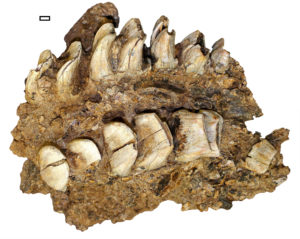Griffith University researchers were part of a group of Australian palaeontologists who announced the discovery of new extinct Australian megafauna that lived until 40,000 years ago in tropical northern Australia and the reason for their demise.
The research, led by the Queensland Museum, and including experts from Griffith University, and a host of other Australian universities, concluded that humans were not to blame for the extinction of the northern megafauna. Extreme environmental change was the most likely culprit.
The findings published in Nature Communications outline how a gradual decrease in water flow, intensified drying, increased burning and vegetation change drove the extinction of at least 13 species of super-sized megafauna species, including four reptilian megapredators, a marsupial ‘lion’ and the world’s largest wombats and kangaroos.

The fossils were discovered at an area near Mackay called South Walker Creek, once home to at least 16 species of megafauna.
Associate Professor Julien Louys, from Griffith University’s Australian Rivers Institute (ARI), helped excavate the site, recovering several of the megafauna fossils. While, Dr Tim Pietsch and Emeritus Professor Jon Olley, also from ARI helped date the fossils discovered at the site.
“We did this by dating the sediments above, within, and below the fossil using Optically Stimulated Luminescence, which determines the last time the quartz in the soil was exposed to light,” Dr Pietsch said.
“If the site hasn’t been disturbed, then the soil around the fossil is the same age as the fossil itself.”
“We found that the age of the fossils spanned from about 60,000 to 40,000 years old, meaning that these giant beasts coexisted on the Australian continent with humans for tens of thousands of years.”
The dating demonstrated that the South Walker Creek site was the youngest such site in northern Australia. It was the stomping ground for a diverse range of megafauna including several new species, which are yet to be formally described.
“The megafauna at South Walker Creek were uniquely tropical, dominated by huge reptilian carnivores and mega-herbivores that went extinct around 40,000 years ago, well after humans arrived onto mainland Australia,” Dr Scott Hocknull from Queensland Museum said.
Some of the highlights from the site included the discovery of the remains of the world’s largest kangaroo at 2.5 metres tall and an estimated mass of 274kg.

“While the rest of the world had giant carnivores like sabre-toothed cats, bears and hyenas, Australia’s predators were mostly giant reptiles, including an extinct freshwater croc around 7-metres long,” Dr Hocknull said.
“There were also two giant lizards including a 6-metre long lizard called Megalania and another giant lizard, similar in size to the Komodo Dragon.”
“Although humans were on the continent at this time, there’s no local evidence of their presence at this 40,000-year-old crime scene,” Associate Professor Louys said.
“Since humans didn’t have any interaction with these particular beasts, they couldn’t have contributed to their extinction.”
Associate Professor Louys used his experience with megafauna ecosystems in Africa and Southeast Asia, to help investigate the impacts of environmental change on the ecology of these large mammal communities in Australia.
“We found that their extinction coincided with major climatic and environmental deterioration, both locally and regionally, including increased fire, reduction in grasslands and loss of freshwater. Together, these sustained changes were simply too much for the largest of Australia’s animals to cope with,” Associate Professor Louys said.
“Not since the time of the dinosaurs has Australia been home to such magnificent giants, and yet within a geological instant they were gone forever,” Dr Hocknull said. “There is a message in that for all of us”.
